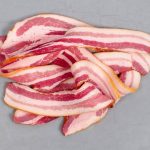 The term back bacon is redundant in that bacon derives from the Old German bach, meaning back; bacon, after all, is cut from the back of the pig, although the sides, which contain more fat, can also be used to produce this cured meat. The word bacon did not appear until the early fourteenth century; before this, the back cut was called a flitch, a word that derives from the same source as the word flesh. When the word bacon was introduced, flitch, rather than become obsolete, shifted its sense and came to denote a whole chunk of bacon before it is cut into slices; thus, the phrase flitch of bacon arose. Throughout the Middle Ages and even beyond, it was just such a flitch of bacon that could be won by any married couple in Dunmow, England who could prove that their first year of marriage had been free of arguments; from this custom the saying bring home the bacon developed. The English surname Bacon—as in Sir Francis Bacon—and the German surname Bach—as in Johann Sebastian Bach—both derive from, the name of this part of the pig.
The term back bacon is redundant in that bacon derives from the Old German bach, meaning back; bacon, after all, is cut from the back of the pig, although the sides, which contain more fat, can also be used to produce this cured meat. The word bacon did not appear until the early fourteenth century; before this, the back cut was called a flitch, a word that derives from the same source as the word flesh. When the word bacon was introduced, flitch, rather than become obsolete, shifted its sense and came to denote a whole chunk of bacon before it is cut into slices; thus, the phrase flitch of bacon arose. Throughout the Middle Ages and even beyond, it was just such a flitch of bacon that could be won by any married couple in Dunmow, England who could prove that their first year of marriage had been free of arguments; from this custom the saying bring home the bacon developed. The English surname Bacon—as in Sir Francis Bacon—and the German surname Bach—as in Johann Sebastian Bach—both derive from, the name of this part of the pig.
The preserved dorsal and lateral sections of the swine wherein an optimal amalgamation of adipose and muscular tissues is sought-after.
Bacon is a popular and delicious cut of meat that comes from the side of a pig. This cut includes the skin or rind, fat, and a layer of meat, all of which are cured in a mixture of brine or salt and saltpeter before being smoked. Bacon is sold in one piece or large chunks that can be sliced at home or by the butcher, and is often referred to as “slab bacon”. Jowl bacon square is another type of bacon that is made from the jowl of the pig. This cut is shaped, cured, and smoked, and has a high fat content that is distributed throughout the meat. The outer surface of jowl bacon square is covered in rind and can be cooked in one piece or sliced. While bacon is a beloved food enjoyed by many, health food students often avoid it and other preserved foods due to the presence of sodium nitrite in the curing process.
